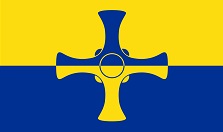

 Here are the details of maps for Ushaw Moor:
Here are the details of maps for Ushaw Moor:

This detailed map covers the village of Ushaw Moor with part of New Brancepeth at the bottom. The principal features are the Ushaw Moor and New Brancepeth collieries and cokeworks, with their connections to the Deerness (or Dearness) Valley Railway. Other features include Eshwood Hall, Biggins, Hare Holme Chapel, Sleetburn Mill Farm etc. (Note that Ushaw College is not on this map.)
The map links up with sheet 16.02 Esh Winning to the west.
Further information:
Until the mid 19th century Ushaw Moor was merely a remote part of Esh parish, but the development of Ushaw Moor colliery led to the growth of a substantial colliery village. At first this colliery was noted for poor working conditions, with substandard housing nearby, leading to a major strike in the 1880s. However, Pease & Partners then bought the colliery and cokeworks and a better village was developed around the crossroads. It was also served by a station on the Dearness Valley line. Across the river, in Brandon & Byshottles parish, was another large colliery with its own village, New Brancepeth. This map covers Ushaw Moor and part of New Brancepeth at a fairly early stage of development, with their collieries, cokeworks and railway.
....."Other mineowners and landowners now saw the potential of the coalfield. In the 1850s a small drift mine was established at Ushaw Moor by the Holliday family, who already owned a small drift mine in Esh, and they sold coal on a landsale basis. The railway brought more ambition and by 1865 John Sharp & Co had sunk a shaft and later opened a range of beehive coke ovens. At some stage Joseph Love, later a partner in Ferens & Love who developed Cornsay Colliery, seems also to have been involved. In 1874, however, the colliery and cokeworks were taken over by Henry Chaytor, who had reclaimed the family home of Witton Castle when its buyer, Donald MacLean MP, had become bankrupt in the 1840s. The shafts gave access to four major seams of coal, the Harvey Seam (156 ft), Yard Seam (197 ft), Busty Seam (272 ft) and Brockwell Seam (366 ft). Chaytor, already an elderly man, appointed his nephew Lawrence as colliery agent, and by the early 1880s around 200 men were being employed here, with much of the coal being converted into coke at a range of 122 beehive-style ovens. As with other Deerness Valley collieries, much of this was then taken to staiths at Dunston or Tyne Dock for export to northern Europe...."